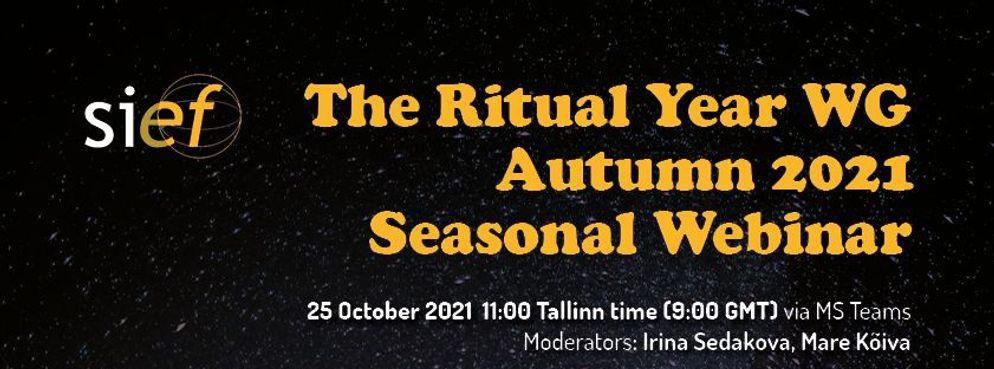25. oktoobril algusega kell 11.00 toimub Rahvusvahelise Etnoloogia ja Folkloori Ühingu rituaalse aasta töörühma veebiseminar taevakehadest mütoloogias.
21.10.2021
Emily Lyle Edinburghi ülikoolist kõneleb ühesilmsete jumalate müüdist, Oksana Tchoekha Slaavi Uuringute Instituudist vaatleb Päikese ja Kuu kujutamist inimolendina ning Tsimafei Avilin Valgevene Kultuuri-, Keele- ja Kirjanduse Uurimise Keskusest tutvustab rahvaastronoomiat.
Seminar toimub Teamsi vahendusel, osalemiseks klõpsa siia!
Edastame pöördumise:
Dear Ritual Year Members,
We are ready to announce our next Ritual Year Seasonal Webinar!
The Autumn 2021 webinar will take place on Monday, 25 October 2021, at 11:00 Tallinn time (09:00 GMT) via MS Teams and will be dedicated to mythology and celestial bodies.
Emily Lyle, our Honorary Chair, will open our meeting with a talk that develops one of her old topic of interest, previously presented in 2014. She will be followed by two researchers from Russia and Belarus.
The titles and the abstracts of the presentations are as following:
- Emily Lyle (University of Edinburgh) The Myth of the One-Eyed God and the Signal Star at the Start of a Season
At the Ritual Year WG’s 10th conference, in Innsbruck, I spoke about a proposed eight-point ritual year known to the Proto-Indo-Europeans (see The Ritual Year 10). One set of four related to the life-cycle of birth, initiation, marriage and death while the other set of four commemorated the victories of the young hero god over the monstrous old cosmic gods. More can now be said in the Scandinavian and Celtic contexts about the myth of the contest of the young god (Thor, Lug) with the cosmic sky god (Geirrod/Odin, Balor/Bres) who posed a threat to the earth by being too hot and burning it up. The hero throws the glowing eye of the god into the distance where it becomes a star (the Pleiades cluster). This star cluster is of great value to humankind because it signals the start of agricultural activities.
- Oksana Tchoekha (Institute of Slavic Studies, Russian Academy of Sciences) Human life of the celestial bodies
Modern Greek legends are the subject of this paper with a special focus on the Sun and the Moon and other celestial bodies portrayed as human beings, exhibiting both their strengths and frailties. Both the Sun and the Moon are provided with a life story including an history involving marital and family relationships; quite frequently among themselves, e.g. believed to be either siblings or married couples.
- Tsimafei Avilin (Center for Studies of Belarusian Culture, Language and Literature, National Academy of Sciences of Belarus) Belarusian Folk Astronomy: What is Your Ritual About?
The presentation starts with a short introduction into Belarusian folk star names (astronyms) and provides an overview of practices related to the starry objects in East Slavonic and Belarusian folk knowledge. Particular examples deal with meteors or so-called falling stars and even dragons.
The webinar and the discussions will be moderated by Irina Sedakova and Mare Koiva.
As usual, our e-meeting will be hosted by the Estonian Literary Museum and the Centre of Excellence in Estonian Studies (Tartu).
For participation, please write to me, at ritualyear@siefhome.org.
You will be sent a link that will be activated half-an-hour before the event.
The event poster can be downloaded here.
Looking forward to seeing you again,
Yours,
Irina Stahl
Senior Researcher, Institute of Sociology, Romanian Academy
SIEF Executive Board Member
Secretary, The Ritual Year WG (SIEF)
ritualyear@siefhome.com

